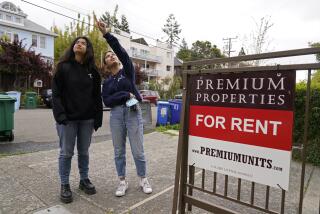U.S. home resales drop almost 17% in December
Sales of previously owned homes nationwide plunged steeply in December, raising concerns that the housing recovery could lose steam after government policies intended to support it expire in the spring.
For now, California appears to be bucking the downward trend.
U.S. sales in December fell to a seasonally adjusted annual rate of 5.45 million units, down 16.7% from November, the National Assn. of Realtors said Monday. It was the biggest drop in the 42 years that the group has been measuring home sales and comes after first-time home buyers raced to close on their purchases before a federal tax credit of up to $8,000 for first-time purchasers was set to expire Nov. 30.
Congress in early November extended the deadline to April 30 and expanded the credit to include up to $6,500 for some buyers who already own homes. The renewal didn’t pull in as many buyers in December, with first-time buyers declining to 43% of all buyers in December from 51% in November, according to a survey by the Realtors group.
“People bought homes in October and November thinking that the tax credit would expire at the end of November, and therefore the decline in December is just a reflection of that,” said Mark Zandi, chief economist at Moody’s Economy.com. “It does highlight a broader point that the housing market is on government life support, and when it is taken off that support, it weakens.”
A slew of federal policies -- including the tax incentives for buyers, low interest rates driven down by Federal Reserve actions and increased access to mortgages backed by the Federal Housing Administration -- bolstered the nation’s housing recovery last year.
But those props eventually will end: The tax credits expire in April, many economists expect interest rates to rise again this year and the FHA is tightening its lending standards. The question remains whether home sales and prices will fall without the government’s help.
Lawrence Yun, chief economist of the Realtors association, said home sales were likely to pick up again in April once the new deadline approached, but the outlook beyond that was unclear as a potential new wave of foreclosures and stubborn unemployment could stymie any recovery.
“By early summer, the overall market should benefit from more balanced inventory, and sales are on track to rise again in 2010,” Yun said in a statement. “However, the job market remains a concern and could dampen the housing recovery -- job creation is key to a continued recovery in the second half of the year.”
The national median price for all previously owned homes was $178,300 in December, 1.5% higher than in December 2008. The median is the point at which half the homes sold for more and half for less.
Sales for the full year increased 4.9% to 5.16 million compared with 2008, the first annual gain since 2005.
Housing in California appears to be faring better than the rest of the nation despite higher unemployment.
Sales of previously owned homes in the West fell 4.8% in December from November, compared with a decline of 19.5% in the Northeast, a 25.8% drop in the Midwest and a decline of 16.3% in the South, the national group said.
In California, resales rose 4% from the previous month, according to figures released last week by the California Assn. of Realtors.
A separate report by the research firm MDA DataQuick of San Diego, which tracks sales of all homes, also showed the Southern California, San Francisco Bay Area and statewide housing markets gaining ground in December.
“Particularly in California, there is a lot of investor demand for a lot of the foreclosed properties and short sales,” or homes sold for less than the value of their mortgages, Zandi of Moody’s Economy.com said.
“It goes to a different psychology in much of the California market,” he said, “where I think home buyers are conditioned to believe that if they buy in times like these, when prices are low, they will be rewarded in the long run.”
Glenn Kelman, chief executive of the online brokerage Redfin, said the Los Angeles area posted strong sales in December as well as the first two weeks of January.
“The December uptick in rates freaked out buyers a little bit and got them moving again,” he wrote in an e-mail. “If rates keep going up, at some point buyers won’t be motivated; they’ll just be scared off. But at least for the first half of January, we saw more people than we ever have ask to go on their first home tours with us, which is an early but fairly reliable indicator of strong demand.”
Robert Kleinhenz, deputy chief economist for the state Realtors group, said another reason for the state’s progress was that buying a home has become increasingly affordable relative to household income in the state over the last few years. According to the group’s affordability index, 64% of households could afford to buy a home at the end of the third quarter of last year compared with a historic low of only 26% in the second quarter of 2006.
“We had much steeper price declines than what occurred nationally, and I think that has been continuing to drive sales,” he said. “Our affordability factors are much, much better than just a few years ago, and, relatively speaking, that improvement was far more dramatic here in California.”
More to Read
Inside the business of entertainment
The Wide Shot brings you news, analysis and insights on everything from streaming wars to production — and what it all means for the future.
You may occasionally receive promotional content from the Los Angeles Times.








